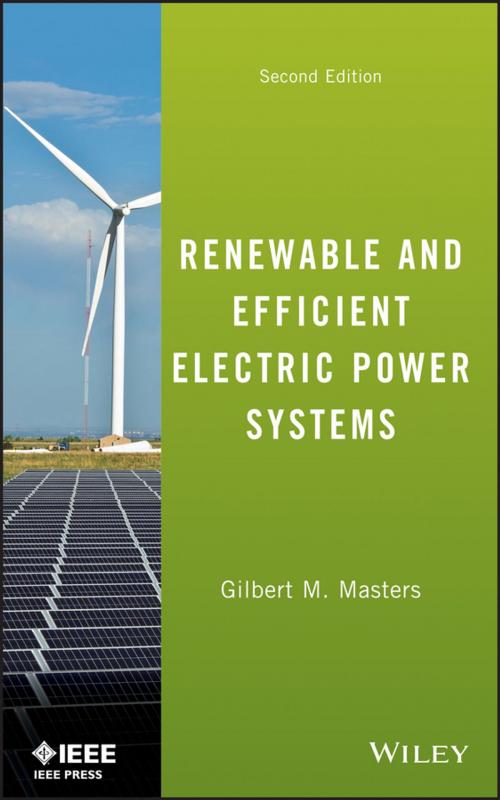Renewable and Efficient Electric Power Systems
Nonfiction, Science & Nature, Technology, Power Resources| Author: | Gilbert M. Masters | ISBN: | 9781118633496 |
| Publisher: | Wiley | Publication: | June 5, 2013 |
| Imprint: | Wiley-IEEE Press | Language: | English |
| Author: | Gilbert M. Masters |
| ISBN: | 9781118633496 |
| Publisher: | Wiley |
| Publication: | June 5, 2013 |
| Imprint: | Wiley-IEEE Press |
| Language: | English |
A solid, quantitative, practical introduction to a wide range of renewable energy systems—in a completely updated, new edition
The second edition of Renewable and Efficient Electric Power Systems provides a solid, quantitative, practical introduction to a wide range of renewable energy systems. For each topic, essential theoretical background is introduced, practical engineering considerations associated with designing systems and predicting their performance are provided, and methods for evaluating the economics of these systems are presented. While the book focuses on the fastest growing, most promising wind and solar technologies, new material on tidal and wave power, small-scale hydroelectric power, geothermal and biomass systems is introduced. Both supply-side and demand-side technologies are blended in the final chapter, which introduces the emerging smart grid. As the fraction of our power generated by renewable resources increases, the role of demand-side management in helping maintain grid balance is explored.
Renewable energy systems have become mainstream technologies and are now, literally, big business. Throughout this edition, more depth has been provided on the financial analysis of large-scale conventional and renewable energy projects. While grid-connected systems dominate the market today, off-grid systems are beginning to have a significant impact on emerging economies where electricity is a scarce commodity. Considerable attention is paid to the economics of all of these systems.
This edition has been completely rewritten, updated, and reorganized. New material has been presented both in the form of new topics as well as in greater depth in some areas. The section on the fundamentals of electric power has been enhanced, making this edition a much better bridge to the more advanced courses in power that are returning to many electrical engineering programs. This includes an introduction to phasor notation, more emphasis on reactive power as well as real power, more on power converter and inverter electronics, and more material on generator technologies. Realizing that many students, as well as professionals, in this increasingly important field may have modest electrical engineering backgrounds, early chapters develop the skills and knowledge necessary to understand these important topics without the need for supplementary materials.
With numerous completely worked examples throughout, the book has been designed to encourage self-instruction. The book includes worked examples for virtually every topic that lends itself to quantitative analysis. Each chapter ends with a problem set that provides additional practice. This is an essential resource for a mixed audience of engineering and other technology-focused individuals.
A solid, quantitative, practical introduction to a wide range of renewable energy systems—in a completely updated, new edition
The second edition of Renewable and Efficient Electric Power Systems provides a solid, quantitative, practical introduction to a wide range of renewable energy systems. For each topic, essential theoretical background is introduced, practical engineering considerations associated with designing systems and predicting their performance are provided, and methods for evaluating the economics of these systems are presented. While the book focuses on the fastest growing, most promising wind and solar technologies, new material on tidal and wave power, small-scale hydroelectric power, geothermal and biomass systems is introduced. Both supply-side and demand-side technologies are blended in the final chapter, which introduces the emerging smart grid. As the fraction of our power generated by renewable resources increases, the role of demand-side management in helping maintain grid balance is explored.
Renewable energy systems have become mainstream technologies and are now, literally, big business. Throughout this edition, more depth has been provided on the financial analysis of large-scale conventional and renewable energy projects. While grid-connected systems dominate the market today, off-grid systems are beginning to have a significant impact on emerging economies where electricity is a scarce commodity. Considerable attention is paid to the economics of all of these systems.
This edition has been completely rewritten, updated, and reorganized. New material has been presented both in the form of new topics as well as in greater depth in some areas. The section on the fundamentals of electric power has been enhanced, making this edition a much better bridge to the more advanced courses in power that are returning to many electrical engineering programs. This includes an introduction to phasor notation, more emphasis on reactive power as well as real power, more on power converter and inverter electronics, and more material on generator technologies. Realizing that many students, as well as professionals, in this increasingly important field may have modest electrical engineering backgrounds, early chapters develop the skills and knowledge necessary to understand these important topics without the need for supplementary materials.
With numerous completely worked examples throughout, the book has been designed to encourage self-instruction. The book includes worked examples for virtually every topic that lends itself to quantitative analysis. Each chapter ends with a problem set that provides additional practice. This is an essential resource for a mixed audience of engineering and other technology-focused individuals.















